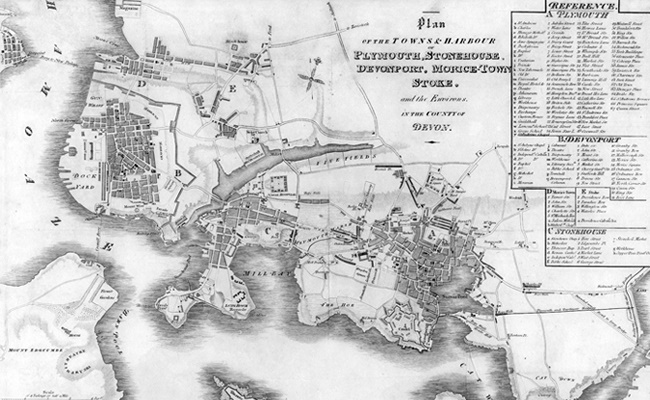

The origins of Plymouth can be traced back to Saxon times, more than a thousand years ago, and its history very much reflects its maritime location.
Farmland on a small peninsula at the mouth of the river Plym, referred to in the Domesday Book in 1086 as Sudtone, meaning South Farm, developed into Sutton Harbour, the hub of medieval Plymouth. Plymouth established its reputation both as a centre for voyage and discovery, and for its military importance.
In 1572 Sir Francis Drake became the first Englishman to sail into the Pacific, and in 1577 he embarked on the first ever circumnavigation of the globe. Back in Plymouth, Drake masterminded the defeat of the Spanish Armada in 1588. According to popular legend, he played bowls on Plymouth Hoe as the Armada sailed up the Channel. Drake was responsible also for the establishment of England's first colony, at Roanoke in Virginia, an act that may be regarded as the origins of the British Empire.
Perhaps the most celebrated expedition to leave Plymouth was that of the Pilgrims. Persecuted for their puritan beliefs in eastern England, they set sail for the New World on board the Mayflower in 1620. After spending a few weeks in Provincetown at the tip of Cape Cod, they eventually landed in Plymouth Harbor and helped to establish a new Plymouth community.
Further explorations that left from Plymouth included three voyages to the southern ocean and the Pacific made by James Cook, the first in 1768. He was the first explorer to set foot on what are now the Hawaiian Islands, where he died in 1779.
In 1831 Charles Darwin left Plymouth for the Galapagos Islands, where he formulated his revolutionary theories of natural selection and the Origins of Species.
Plymouth's military expansion began in earnest in 1670 when a citadel was built on the highest point above the town, the Hoe, meaning high ground. In 1690 the first Royal Dockyard opened on the banks of the Tamar west of Plymouth.
Further docks were built in 1727, 1762 and 1793, and a huge naval complex was later established, including the communities of Plymouth Dock and Stonehouse. The Navy's role during war against Napoleon's France was pivotal, and in 1812 a mile-long breakwater was laid to protect the fleet.
Throughout the nineteenth century the population and physical size of the towns increased dramatically. In 1824 Plymouth Dock was renamed Devonport, and in 1914 the three towns of Plymouth, Devonport and Stonehouse were united as the Borough of Plymouth.
In 1928 Plymouth was granted City status. Plymouth was heavily bombed during the Second World War. Plymouth's and Devonport's centres were destroyed. Re-built in the 1950s, Plymouth's commercial heart was the first in England to incorporate pedestrian-only shopping avenues.
Victorian and Edwardian maps show that the Three Towns of Plymouth, Devonport and East Stonehouse had merged into one. They were though still separate towns, with their own identity, local government and civic pride.
It was the threat of war and a need to speed decision making that led to the Three Towns being joined together under one authority in 1914. Devonport Corporation fought the plan but it had popular support.

Plymouth became a City in 1928. The boundaries were redrawn in 1938 and 1951, each time adding to the population. The Plympton and Plymstock areas, which had both grown steadily after the First World War, were added in 1967.
Although some 5000 council houses and flats were built between the wars, including large council estates in the Swilly and North Prospect area, there was an ever-growing movement of people into new houses outside the City. Plympton and Plymstock were growing fast to the east and, following a boundary change, the City was extended to the north in 1938.
.jpg)
In the Second World War Plymouth was one of the most badly bombed cities in England. The ‘Blitz’ caused widespread damage; flattening large parts of the city centre, central Devonport and areas of Stonehouse. By 1943-4, before the War had ended, there was a revolutionary plan in place to create a new modern City.
.jpg)
The port of Plymouth has a rich maritime history based on fishing, trade and a long and continuing association with the Royal Navy. The sea has touched the lives of everyone who has lived-in or visited the port of Plymouth. The sea continues to shape the modern City.
.jpg)
Plymouth is located in the south west of Britain on the Western Approaches to the English Channel. Plymouth Sound is a natural harbour at the meeting point of the Rivers Plym and Tamar, providing two important, navigable routes inland to West Devon and East Cornwall.
Originally a small town, Plymouth prospered as a centre of fishing and trade. Local, coastal and continental trade grew steadily, especially cross-Channel trade with France and Spain. It became Britain’s south-western gateway to the world’s oceans. Fortifications were built and the port became established as a military and naval base, vital to the nation’s defence.
.jpg)
Past and present, Plymouth is about the sea - sailors in peace and war, voyages of adventurers and exploration; passenger arrivals and departures; ship building and ship repair; merchants and maritime traders; cargoes, docks and warehouses; the sea as both a place of work and as a place of leisure.